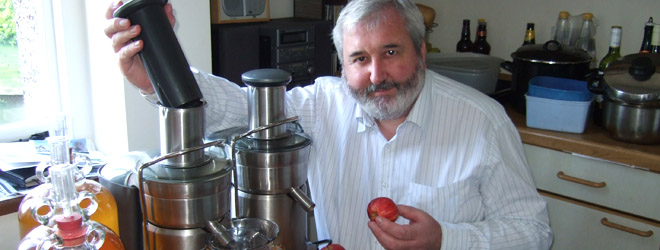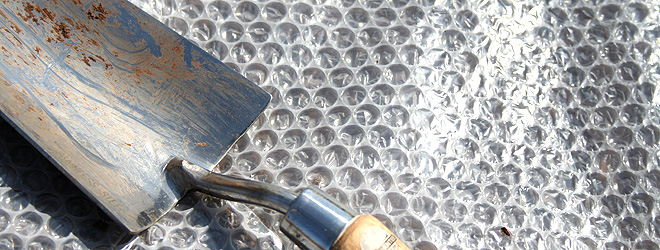Think you need a full scale cider press to rattle out bottles of home made cider? Think again. We speak with Nevin Stewart, a cider enthusiast who has developed a ‘juice and strain’ method using simple kitchen equipment…
You’ve developed a process for making cider with a kitchen juicer. What inspired you to take up this challenge?
This came about largely by chance. 2011 saw a bumper apple crop in the gardens of Scillonian Road, Guildford where I, and my neighbours live.We were faced with the challenge of what to do with 500kg of surplus apples Every culinary use that we could think of had been exhausted and still we had all these apples.We couldn’t even give them away as everybody in the neighbourhood was faced with the same happy problem – what to do with all these apples?
It was over a pub lunch that we retired gentlemen of Scillonian Road decided that we would give cider making a go. We’d not done this before but we were game to give it a try. None of us wanted to spend any serious money on making cider. So the traditional route of buying, or hiring, pulp and press kit was denied to us. Instead my daughter offered up her small kitchen juicer which would accept slices of apple and off we went.
How did you arrive at your ‘juice and strain’ process?
In our first juicing session three of us spent three hours feeding slices of apples, minus the pips, into this small machine and we ended up with three gallons of juice. We realised that this just wasn’t going to work with half of one tonne of fruit avaialable to us. Our breakthrough came when my neighbour and friend, Nick, spotted a large whole fruit juicer in a charity shop and told me about this. I shellled out the £15 asking price and we tried again. This time our efficiency was transformed, by at least a factor of ten. In that first season we produced 64 gallons of juice most of which we fermented out to cider.
In the winter that followed I was interested to quantify just how efficient a whole fruit juicer can be. I bought a range of six different machines on ebay and checked them all out, each on a standard scale of apples. What I found was that they all gave much the same yield of juice at about 65% of the apple weight. The main difference was in the processing rate. As the machine power rating increased so did the speed with which you could push apples through it. At the top of the power range a 1200W machine could process about 3kg of apples in a minute giving you a gallon of juice in under three minutes. This including time to empty the pulp container when full.
There were also messy limitations to the way in which we carried out the juicing work. We were having spillages of apple juice on the kitchen floor and even some on to the walls too. My wife was taking a dim view of all of this, as you can well imagine. However, two innovations tidied up the whole business and transformed juice and then strain into a synchronous juice and strain, at the same time, process.
The first of these innovations was the so-called “juice containment and delivery adaptor”, aka a hose. This fitted onto the conveniently shaped juicer outlet spout and fed juice with fines into the straining bag. At first we just held the bag in place within a large fermenting bin by tying it in place with string. The problem there was that the bag would fill up and, if we wanted to change over to an empty one, it would take two of us to man handle the bag out and all the time it was wanting to spill its contents. The solution was a straining bucket into which the straining bag sat. This bucket, having a myriad of small holes drilled into its base, slotted neatly into the top of the fermenting bin.
Once these changes had been made what we had was a synchronous juice and strain process. Whole apples go in at the top, they are juiced, the juice goes down the hose into the waiting straining bag and bucket, the juice drips through and is collected in the large 25litre fermenting bin which has a tap at its base, and clear apple juice can be drawn off by the gallon. This to be consumed fresh, or yeast added and allowed to ferment out in a demi john to cider.
Whole apples in at the top, clear juice out at the bottom – as our first YouTube video shows, Cider making made simple.
What are the advantages of using a juicer over more traditional presses?
Our juice and strain process is now low cost, quick, clean, efficient, compact and suited to use in a domestic kitchen. The clear juice yield at 65% by weight of apples compares very favourbly with the about 40% yield that you can expect from a basic hand-cranked scratter and press kit. Also our juicing step is about five times faster.
Some kitchen appliances are better than others. What should prospective cider makers be looking for in their juicer?
I consider it essential to buy a machine that has a spout to which a hose can be attached, and held clamped in place. Also I would recommend buying a heavy duty machine with as high a power rating as your budget will allow.
Your apples are sourced from local gardens. Do you have any favourite varieties for cider making?
Our original 2011 cider, Onslow’s Dry, was mostly made from dessert apples taken from a single tree of unknown variety. This supply has been supplemented by purchase of dessert fruit from our local Guildford market. We have now made single varietal ciders from Braeburn, Fuji, and Pink Lady apples. All these have turned out crisp, light and refreshing and many people have likened our bottle conditioned ciders to champagne. This may be due. in part, to us using a champagne yeast.
Have you tucked any other fruit into the juicer with the apples to make any trendy flavoured ciders?
My only attempt at this was with pineapples that I bought on a Tesco special promotion. I mixed apples with pineapples in the ratio 4:1 and the juicing worked out fine. What came as a surprise was the persistent voluminous foam generated in the early stages of fermentation. In addition to me washing the kitchen floor again, this necessitated transferral of the fermenting juice from three demijohns into a 25 litre fermenter to allow sufficient headspace. After a few days, when the alcohol content had increased, the foam collapsed and fermentation proceeded to completion as usual. As you can probably imagine the finished product is quite sharp. However, it does have a very pleasing bouquet and flavour
You’ve got an interesting challenge with a cider press coming up later this year. Tell us more about that.
Together with a bespoke scratter and press maker, we have been invited to demonstrate the pulp and press, and juice and strain methods of obtaining fresh apple juice at the Brogdale Cider Festival, 23rd and 24th August 2014. Our demonstration will take the form of a contest between these two alternative methods in a “fair test” trial. This promises to be educational, instructive and, most of all, fun. The pulp and press team will be led by Peter Eveleigh of Hardwood Crafts. Peter and his co-worker will be equipped with an electric mill, and two manual presses – a 32 litre barrel press and a 50 litre rack and cloth press, all of his own fabrication. At approximately half the capital outlay, I, and one other, will put our two high performance juicers to the juice and strain task. Each team will have a 100kg of washed apples and one hour in which to do their best work. Yield of juice produced in a given time, and other key measures, will be recorded.
For more information about Nevin’s cider adventures, visit his blog at http://juiceandstrain.wordpress.com/







